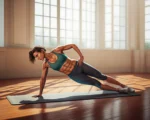When it comes to living a healthier, happier life, focusing on diet and fitness is one of the most impactful steps you can take. Whether you’re new to the world of exercising and clean eating, or you’re a fitness enthusiast looking to refine your approach, the connection between what you eat and how you move cannot be overstated.
This comprehensive guide will explore how diet and fitness work together, the benefits of aligning them, and actionable tips to help you kickstart or refine your wellness routine.
What is Diet and Fitness?
At its core, “diet and fitness” refers to the balance between nourishing your body with the right nutrients while staying physically active to improve overall health and well-being.
- Diet encompasses the food and drink choices you make to fuel your body. This includes macronutrients (carbohydrates, proteins, fats) and micronutrients (vitamins and minerals).
- Fitness relates to your physical activity levels, strength, cardio endurance, flexibility, and overall physical performance.
When combined thoughtfully, diet and fitness can work synergistically to help you achieve your health and wellness goals.
Why the Diet and Fitness Combo Matters
Many people focus solely on either diet or exercise, but the reality is that both work better together. Here’s why:
1. Enhanced Energy Levels
The food you eat fuels your workouts. A balanced diet provides your body with the energy it needs to perform at its best during exercise and recover afterward.
2. Muscle Recovery and Growth
Protein-rich diets combined with an exercise routine (like strength training) ensure that your muscles have what they need for recovery and growth.
3. Sustainable Weight Management
Combining a nutrient-dense diet with a consistent fitness routine is more effective for long-term weight management compared to focusing on either one alone.
4. Mental Clarity and Reduced Stress
Exercise triggers the release of endorphins (feel-good chemicals), while eating the right foods supports brain health, improving focus and reducing stress.
5. Improved Overall Health
Aligning a good diet with regular fitness can reduce long-term health risks such as heart disease, diabetes, and obesity.
Getting Started with Diet and Fitness in 6 Steps
1. Establish Clear Goals
Start by identifying your goals. Are you aiming to lose weight, gain muscle, or improve endurance? Your goals will help guide your fitness routine and what dietary plan suits you best.
2. Choose Nutrient-Dense Foods
Building your diet around nutrient-dense foods ensures your body gets the essential vitamins, minerals, and energy it needs:
- Carbohydrates for energy (e.g., whole grains, fruits, vegetables).
- Protein for muscle repair (e.g., lean meats, eggs, beans, and tofu).
- Healthy fats for brain health and satiety (e.g., avocados, nuts, and fish).
For an added post-exercise punch, include protein-rich recovery options like Greek yogurt, chicken breast, or even a high-quality protein shake.
3. Stay Hydrated
Water is vital for optimal performance. Aim for at least 8 glasses of water a day and more during heavy workouts. Dehydration can lead to fatigue, poor performance, and slower recovery.
4. Craft a Fitness Routine You Love
Adherence is key, so focus on activities you find joy in. Explore different options:
- Cardio for heart health (running, cycling, swimming).
- Strength training for muscle building (weightlifting, resistance bands, yoga).
- Flexibility exercises like stretching or Pilates for improved range of motion.
5. Track Your Progress
Keep a journal or use apps to monitor your dietary intake and workout achievements. This can help identify what’s working and where adjustments are needed.
6. Prioritize Rest and Recovery
Sleep and rest days are as critical as workouts. Aim for 7-9 hours of good-quality sleep every night to allow your body to repair and rejuvenate.
How Diet Supports Your Fitness Goals
Pre-Workout Nutrition
Eating a small, carb-heavy snack one or two hours before a workout provides sustained energy. Examples include:
- A banana with peanut butter
- A slice of whole-grain toast with avocado
Post-Workout Recovery
To optimize muscle repair, refuel within 45 minutes after a workout. Combine protein and carbs for the best results:
- A post-workout smoothie with whey protein and berries
- Grilled chicken with sweet potato
Timing is Key
According to insights shared by Harvard Health (as cited in the scraped content), women may benefit more by refueling within 30-45 minutes post-exercise, whereas men may have up to three hours. These specific post-workout strategies help avoid prolonged muscle breakdown and aid endurance.
Overcoming Diet and Fitness Challenges
No routine is without hurdles, but here are tips to keep you on track:
- Busy Schedule? Prioritize meal-prepping and short, effective workouts (like HIIT).
- Budget Constraints? Choose affordable, nutrient-dense staples like eggs, oats, and legumes.
- Lack of Motivation? Join a supportive community or find a workout buddy to stay accountable.
Foster a Community of Support
Building healthy habits is easier when you’re surrounded by like-minded individuals. Consider joining the community at local gyms, online fitness forums, or diet-focused groups. Sharing advice, challenges, and small victories fosters motivation and keeps you inspired.
Call to Action
Transforming your life with a committed diet and fitness routine is one of the best decisions you’ll make. It’s not just about reaching a goal; it’s about cultivating a lifestyle that brings energy, joy, and confidence.
If you’re ready to take the leap, start by exploring healthy recipes, experimenting with new workouts, and learning more about fueling your fitness. Want personalized insights? Subscribe to our newsletter for tailored tips or take the first step toward achieving your best self!
Creating harmony between diet and fitness doesn’t need to be complicated. Take small, sustainable steps, and in no time, you’ll notice the results—not just in how you look, but in how you feel.








